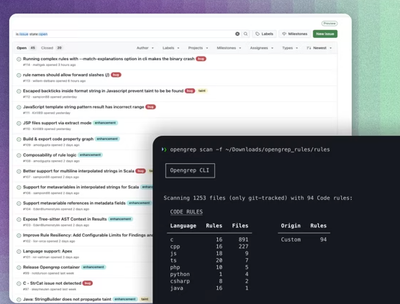
Research
Security News
Lazarus Strikes npm Again with New Wave of Malicious Packages
The Socket Research Team has discovered six new malicious npm packages linked to North Korea’s Lazarus Group, designed to steal credentials and deploy backdoors.
@core-design/components
Advanced tools
*After cloning the repo for the first time, run: npm run build to copy core-icons into the build/assets directory.
To start developing, run:
npm start
To build the component for production, run:
npm run build
To run the unit tests for the components, run:
npm test
Need help? Check out Stencil docs here.
Stencil components are plain ES6/TypeScript classes with some decorator metadata.
Create new components by creating files with a .tsx extension, such as core-component.tsx, and place them in src/components.
import { Component, Prop, h } from "@stencil/core";
@Component({
tag: "core-component",
styleUrl: "core-component.css",
})
export class Component {
@Prop() first: string;
@Prop() last: string;
render() {
return (
<div>
Hello, my name is {this.first} {this.last}
</div>
);
}
}
Note: the .tsx extension is required, as this is the standard for TypeScript classes that use JSX.
To use this component, just use it like any other HTML element:
<core-component first="Stencil" last="JS"></core-component>
Stencil components run directly in the browser through script includes just like normal Custom Elements, and run by using the tag just like any other HTML component:
Here's an example index.html file that runs a Stencil app:
<!DOCTYPE html>
<html>
<head>
<title>My App</title>
<script src="build/app.js"></script>
</head>
<body>
<core-component first="Stencil" last="JS"></core-component>
</body>
</html>
When creating new component tags, use the core- prefix and kebab-case.
For example: core-button, core-icon, etc. Custom Elements must contain a dashed name so they do not collide with existing html element names.
The API for Stencil closely mirrors the API for Custom Elements v1.
| Decorator | Description |
|---|---|
@Component() | Indicate a class is a Stencil component. |
@Prop() | Creates a property that will exist on the element and be data-bound to this component. |
@State() | Creates a local state variable that will not be placed on the element. |
@Method() | Expose specific methods to be publicly accessible. |
@Component({
tag: "core-component",
styleUrls: {
ios: "component.ios.css",
md: "component.md.css",
wp: "component.wp.css",
},
})
export class Component {
/**
* 1. Own Properties
* Always set the type if a default value has not
* been set. If a default value is being set, then type
* is already inferred. List the own properties in
* alphabetical order. Note that because these properties
* do not have the @Prop() decorator, they will not be exposed
* publicly on the host element, but only used internally.
*/
num: number;
someText = "default";
/**
* 2. Reference to host HTML element.
* Inlined decorator
*/
@Element() el: HTMLElement;
/**
* 3. State() variables
* Inlined decorator, alphabetical order.
*/
@State() isValidated: boolean;
@State() status = 0;
/**
* 4. Public Property API
* Inlined decorator, alphabetical order. These are
* different than "own properties" in that public props
* are exposed as properties and attributes on the host element.
* Requires JSDocs for public API documentation.
*/
@Prop() content: string;
@Prop() enabled: boolean;
@Prop() menuId: string;
@Prop() type = "overlay";
/**
* Prop lifecycle events SHOULD go just behind the Prop they listen to.
* This makes sense since both statements are strongly connected.
* - If renaming the instance variable name you must also update the name in @Watch()
* - Code is easier to follow and maintain.
*/
@Prop() swipeEnabled = true;
@Watch("swipeEnabled")
swipeEnabledChanged(newSwipeEnabled: boolean, oldSwipeEnabled: boolean) {
this.updateState();
}
/**
* 5. Events section
* Inlined decorator, alphabetical order.
* Requires JSDocs for public API documentation.
*/
@Event() coreClose: EventEmitter;
@Event() coreDrag: EventEmitter;
@Event() coreOpen: EventEmitter;
/**
* 6. Component lifecycle events
* Ordered by their natural call order, for example
* WillLoad should go before DidLoad.
*/
componentWillLoad() {}
componentDidLoad() {}
componentWillUpdate() {}
componentDidUpdate() {}
componentDidUnload() {}
/**
* 7. Listeners
* It is ok to place them in a different location
* if makes more sense in the context. Recommend
* starting a listener method with "on".
* Always use two lines.
*/
@Listen("click", { enabled: false })
onClick(ev: UIEvent) {
console.log("hi!");
}
/**
* 8. Public methods API
* These methods are exposed on the host element.
* Always use two lines.
* Public Methods must be async.
* Requires JSDocs for public API documentation.
*/
@Method()
async open(): Promise<boolean> {
// ...
return true;
}
@Method()
async close(): Promise<void> {
// ...
}
/**
* 9. Local methods
* Internal business logic. These methods cannot be
* called from the host element.
*/
prepareAnimation(): Promise<void> {
// ...
}
updateState() {
// ...
}
/**
* 10. render() function
* Always the last one in the class.
*/
render() {
return (
<Host
attribute="navigation"
side={this.isRightSide ? "right" : "left"}
type={this.type}
class={{
"core-is-animating": this.isAnimating,
}}
>
<div class="menu-inner page-inner">
<slot></slot>
</div>
</Host>
);
}
}
Web Components, specifically Custom Elements, are natively supported in Chrome and Safari and are coming to both Edge and Firefox. A dynamic polyfill loader is already included in order to only load the polyfills for the browsers that are missing specific features.
Stencil includes a subset of the core-js polyfills for old browsers like IE11, fetch and conditionally downloads the Custom Elements v1 only when it's needed for modern browsers (EDGE and old versions of Firefox.)
Browsers that do not support native ESM (at the moment, only IE11 and older) will download a subset of core-js.
This subset is generated using the core-js-builder tool with the following configuration:
require("core-js-builder")({
targets: "ie 11",
modules: [
"es",
"web.url",
"web.url.to-json",
"web.url-search-params",
"web.dom-collections.for-each",
],
blacklist: [
"es.math",
"es.date",
"es.symbol",
"es.array-buffer",
"es.data-view",
"es.typed-array",
"es.reflect",
"es.promise",
],
});
In addition, the following set of polyfills are also included:
Some modern browsers like Edge do not include native support for Web Components. In that case, we conditionally load the Custom Elements v1 polyfill.
FAQs
Core Design System Components
The npm package @core-design/components receives a total of 1 weekly downloads. As such, @core-design/components popularity was classified as not popular.
We found that @core-design/components demonstrated a not healthy version release cadence and project activity because the last version was released a year ago. It has 3 open source maintainers collaborating on the project.
Did you know?

Socket for GitHub automatically highlights issues in each pull request and monitors the health of all your open source dependencies. Discover the contents of your packages and block harmful activity before you install or update your dependencies.

Research
Security News
The Socket Research Team has discovered six new malicious npm packages linked to North Korea’s Lazarus Group, designed to steal credentials and deploy backdoors.

Security News
Socket CEO Feross Aboukhadijeh discusses the open web, open source security, and how Socket tackles software supply chain attacks on The Pair Program podcast.

Security News
Opengrep continues building momentum with the alpha release of its Playground tool, demonstrating the project's rapid evolution just two months after its initial launch.